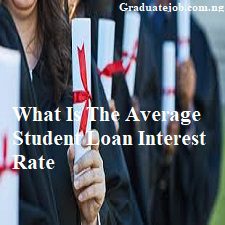The average student loan interest rate for undergraduates is 4.99% for the 2022/23 school year. The interest rate depends on the type of student loan (Private or federal). In this article, we will review the average interest
Overview of the current average student loan interest rate in 2023
| Refinance student loans | Fixed: 5.40% to 9.92% Variable: 4.68% to 9.47% |
| Private student loans | Fixed: 5.99% to 13.78% Variable: 5.61% to 13.27% |
| Federal student loans(fixed) | Undergraduate: 4.99% Graduate: 6.54% PLUS (Parent, Grad): 7.54% |
READ MORE: How To Switch Student Loan Servicers
Student Loan Interest Rates
Student loan interest rates were very low during the 2020-2021 academic year in response to the ever-increasing national student debt, labeled a crisis previously in 1995.
- The average interest rate on all student loans, federal and private, is 5.8%.
- The average interest rate for government loans is 6.36%.
- All federal student loan interest rates grew by an average of 24% between 2020-21 and 2021-22.
- Undergraduate loan interest rates climbed 15% faster than graduate and professional student loan interest rates.
While consolidating federal loans does not lower interest rates, refinancing may.
Federal government’s average student loan interest rate
The Federal government student loan makes up 92.39% of all student loan debt. Federal loan interest rates are fixed, which means they will remain the same as long as the loan is due.
- Between the 2020-2021 and 2021-2022 academic years, the interest rate on all federal student loans increased from 4.12% to 24%.
- Since 2006, the average federal loan interest rate has been 6.06%.
- The undergraduate rate of interest is 4.99%.
- The current undergraduate interest rate has increased by 33.8% year on year.
- The average interest rate for undergraduate student loans during the last five years has been 4.10%.
- Every year on July 1st, federal interest rates are modified.
The weighted average of the interest rates on the merged loans, rounded up, determines the interest rate for a Direct Consolidation Loan.
READ MORE: Student Loan Erudio: All You Should Know
Federal Interest Rates
Although the earliest federal student loan programs date to 1944, they were only available to military veterans until 1958.
- In 1982, federal interest rates rose to 12%.
- In 1988, undergraduates could receive loans at an interest rate of 9%.
- In 1992, federal interest rates rose from 7% to 10%.
- Federal interest rate decreased by an average of 33% between 2010 and 2020.
- The average federal loan interest rate has fallen to 50.4% since 2006.
- From 2006 to 2013, the fixed interest rate for Direct Unsubsidized Loans for undergraduates was 6.8%.
- From 2006 to 2012, the fixed interest rate for graduate and professional students was 6.8%.
- From July 1, 2012, graduate and professional students are no longer eligible for subsidized loans.
- At the beginning of the 2013-2014 academic year, Undergraduate direct Loans had the same interest rate whether they are subsidized or unsubsidized.
- Before the 2013-2014 academic year, interest rates were higher and didn’t always change from year to year.
Graduate, Professional, & Parent Rates
Interest rates for graduate and parents students haven’t declined as much as loans for undergraduates.
- Direct loans for graduate and professional students rose by 23% in 2023.
- PLUS loans for parents and for graduate and professional students rose by 18.5%.
- Between the 2019/2020 and 2020/2021 academic years, interest rates for these loans saw their largest ever YoY declines.
- Graduate and Professional direct loan interest rates are increasing at 15%. This is slower than those for undergraduate loans.
- PLUS loan interest rates rose 16.5% slower than those for undergraduate loans.
- PLUS loan interest rates have increased 4.5% slower, compared to Direct loans for graduate and professional students.
- The now-defunct Federal Family Education Loan Program (FFEL) had a fixed interest rate of 8.5% for graduates, parents, and professional borrowers.
Private loan interest rate
Private lenders have begun to implement strategies similar to federal relief to keep default rates at a low. The current private loan default rate is 2%.
- Official report estimates for the overall average private student loan interest rate ranges from 4% to 15%.
- 16.75% is the highest annual percentage rate (APR) among major private lenders.
- The lowest APR among private lenders is 3.99% (including an auto-pay discount).
- 92% of private undergraduate loans have a cosigner, which typically lowers a borrower’s interest rate.
- 66% of graduate loans are co-signed.
Refinance Loan Interest Rates
Federal and private student loans can only be refinanced via private lenders. A study found that if every eligible borrower refinances their loans, the national average interest rate would drop to 4.2%. The best part is that 52.8% of borrowers are eligible for refinancing.
READ MORE: How Much Student Loan Can I Get In Wales
How average student loan interest rate works
The interest rates on student loans vary based on whether the loan is federal or private. Every borrower who takes out the same sort of federal loan in the same year has the same interest rate. Borrowers with higher credit scores usually qualify for lower interest rates, while borrowers with lower credit scores qualify for higher interest rates.
Federal student loans
- Congress sets annual interest rates based on the 10-year Treasury note.
- Most costs are calculated as a percentage of the entire loan amount.
- Rates are set for the duration of the loan.
Private lender’s student loans
- Interest rates are typically based on credit.
- The majority of private lenders do not impose origination fees.
- Borrowers can select between fixed and variable interest rates.
- Variable rates might fluctuate monthly or quarterly.






